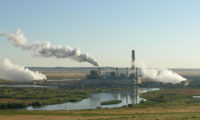In a long-awaited decision, a divided three-judge panel of the U.S. Court of Appeals for the D.C. Circuit has struck down an Environmental Protection Agency rule that aimed to cut powerplants' emissions or air pollutants that move across state lines.
The cross-state air pollution regulation (CSAPR) would have required 28 states in the East, Midwest and South to reduce emissions of sulfur dioxide and nitrogen oxide that cross state lines and cause air-quality problems in downwind states. EPA finalized the rule in July 2011, but the court blocked it from taking effect until it could review the case.
Writing for the court's majority, Judge Brett Kavanaugh, joined by Judge Thomas Griffith, concluded that EPA had imposed “massive emissions reduction requirements on upwind states without regard to the limits imposed by the statutory text” of the Clean Air Act (CAA).
In her dissent, Judge Judith Ann Rogers wrote that the court disregarded “the plain text of the CAA and this court’s settled precedent interpreting the same statutory provisions at issue today.”
The ruling leaves the previous Clean Air Interstate Rule, finalized by the George W. Bush administration in 2005, in place. Environmental advocates say that regulation does not adequately safeguard public health.
In a statement, EPA said it is reviewing the decision and subsequently will determine an “appropriate course of action….EPA remains committed to working with states and the power sector to address pollution transport issues as required by the Clean Air Act.”
Jim Hunter, utilities director for the International Brotherhood of Electrical Workers (IBEW), says the CSAPR was problematic not so much because of its goal of cleaner air, but because the timelines required to meet its requirements were unrealistic. As a result, he says, many utilities would be faced with the Hobson's choice of paying “multi-million dollar fines” or shuttering older plants, and laying off “thousands” of workers. IBEW was one of the interveners in the case against the EPA.
Scott Segal, director of the Electrical Reliability Coordinating Council, a coalition of utilities and energy companies that works on clean air issues, says, “The court was clear in finding that EPA had overstepped its legal authority in developing the rule. EPA had violated a key principle underlying the Clean Air Act—cooperative federalism.”
But environmental groups lambasted the ruling. John Walke, Natural Resources Defense Council clean air director, says that EPA should “immediately appeal this decision. The dissenting judge correctly follows the Clean Air Act and prior rulings by this court. The majority opinion is an outlier at odds with the court’s own rulings as well as the Clean Air Act.” Walke adds that unless the court ruling is overturned, “it will take years for EPA to adopt replacement health safeguards that all three judges recognize to be necessary and required by law.”
The latest news and information
#1 Source for Construction News, Data, Rankings, Analysis, and Commentary
JOIN ENR UNLIMITEDCopyright ©2024. All Rights Reserved BNP Media.
Design, CMS, Hosting & Web Development :: ePublishing



Post a comment to this article
Report Abusive Comment